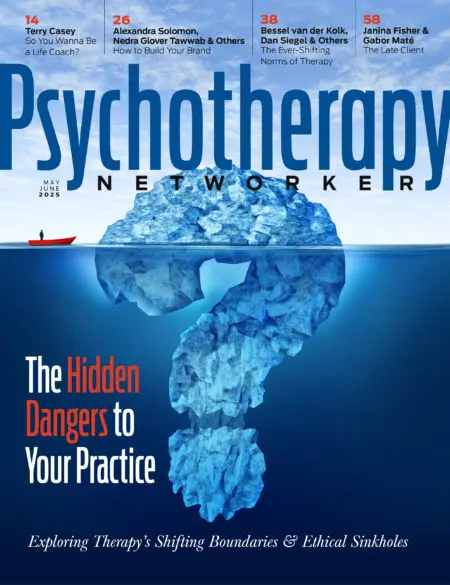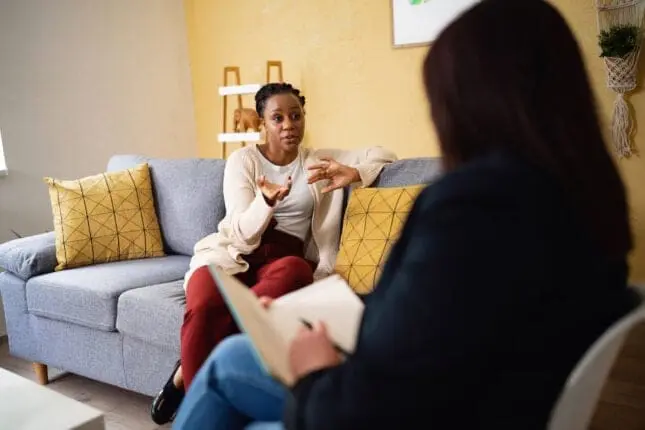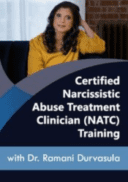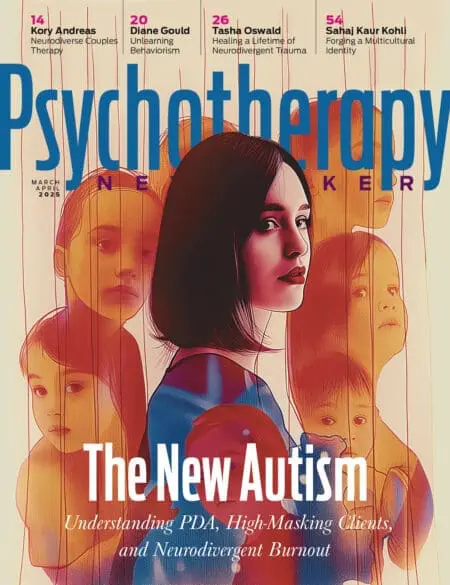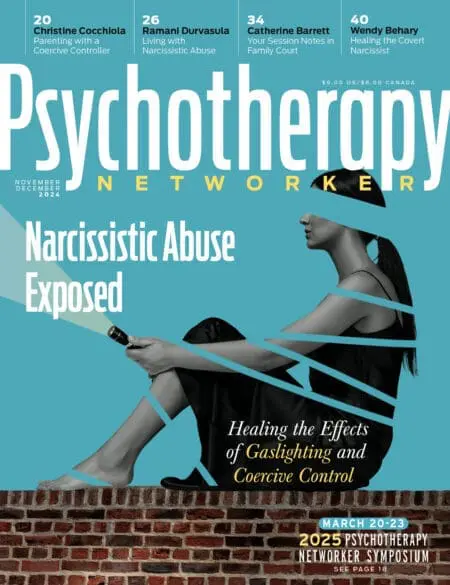Q: I’m a white therapist who sees many nonwhite clients. I consider my interventions to be careful and thoughtful, but how can I ensure my approach is culturally responsive?
A: Your question highlights an important point: although most white therapists may mean well, their clients of color need to experience their cultural responsiveness in action. Being culturally responsive means understanding and embracing your client’s cultural background and identity in therapy. Talking about cultural experiences and identity may be a key part of many clients’ engagement in treatment. It also means showing humility: even the most skilled therapists carry biases. The only way to confront them is through continued reflection and reappraisal of our privilege.
You might be skeptical about whether an old white man like me has anything valuable to say about cultural responsiveness, and rightfully so. Over the course of my 40-year career, I’ve dedicated myself to improving my clinical skills so I can show up for clients with backgrounds different from my own. I’m not unique in that endeavor: many therapists strive to be culturally responsive. But do we know when we’re actually being culturally responsive? Well, yes. We can get a good sense of it by measuring outcomes and getting feedback on the therapeutic alliance.
Using assessments in your work may sound a little mechanical, but measurement-based care is more than just the perfunctory tossing of forms at clients to satisfy our bosses and insurance companies. It’s an evidenced-based practice that identifies when clients aren’t benefitting from our interventions while soliciting and incorporating their feedback so we can achieve better therapeutic outcomes.
When measurements show our cultural responsiveness falling short, we have an opportunity to explore why—a conversation many white therapists find difficult to initiate without a tool to get things rolling. Then, once issues around a cultural disconnect are explored, the therapist can tailor the work to a client’s individual needs while also validating their values, beliefs, and cultural identity. In a nutshell, not only does measurement-based care improve the therapy experience for clients, but it helps white therapists have difficult conversations about racial and cultural issues.
The Road to Cultural Competence
My parents escaped abject poverty in rural Appalachia by traveling north to find factory jobs after World War II, an experience that gave rise to my lifelong combustible anger about class. But despite my pointed awareness of socioeconomic inequality, it took me a while to acknowledge my white privilege. I thought poor was poor, regardless of skin color. But I was wrong. When the Vietnam War and the Civil Rights movement came about in the late ’60s, I saw the truth about the extent of government corruption and institutional racism. I was a senior in high school when the Kent State massacre occurred, and it whipped my simmering class antipathy and antiwar sentiment into full-blown rage. When I entered the University of Cincinnati, I joined the protests, took psychedelics, and got arrested a handful of times (including during the massive 1971 antiwar protest in Washington, DC). After an overdose, I returned home to work in a tire factory—a decision that probably saved my life.
Eventually, I finished my undergraduate degree and entered a psychology doctoral program. Soon, I witnessed the same forces that oppressed and disenfranchised the poor and minorities in society in another form. Psychotherapy clients, I realized, were often regarded as broken, incomplete, or sick—walking, talking embodiments of the DSM who needed an all-knowing therapist to “fix” them. These glaring problems inspired me to incorporate a much-needed dose of humility into the therapy process by privileging client perspectives about their own experiences with me. Eventually, I created a blueprint for client-directed care to counteract damaging assumptions and power imbalances in treatment.
In the late-’90s, I was inspired by researcher Michael Lambert’s groundbreaking idea of using outcome measures to notify therapists when clients weren’t benefiting from therapy, thereby preventing treatment failure. This approach struck me as revolutionary. It meant that client perceptions of the usefulness of therapy could actually direct the therapeutic process, which helped me begin to think about measurement-based care as a social justice initiative. After developing much briefer measures, I experimented with them in my private practice, and with graduate students I was supervising in a free south Florida clinic that served lower income folks and many immigrants from the Caribbean, Central, and South America. After two years, I developed my own measurement-based care method, the Partners for Change Outcome Management System (PCOMS).
PCOMS includes two four-item scales, the Outcome Rating Scale (ORS), which measures how the client is benefitting from treatment, and the Session Rating Scale (SRS), which monitors the therapeutic alliance. I found that the ORS provided an opening to explore systemic stressors, like oppression and discrimination, while the SRS created space to discuss ethnic, racial, sex, and gender-orientation differences between the therapist and client. I use these scales in every session to help me monitor the client’s experience and make fixes before the quality of treatment can suffer. My goal in creating PCOMS was to level the playing field in therapy, inviting collaborative decision-making and assigning value to clients and their cultural knowledge.
Casandra
My client Casandra, a 22-year-old Black woman, had struggled with drugs for years. She’d stayed clean for a while, but eventually relapsed, and when a neighbor found her two young children visibly distressed with my client passed out on the front porch, he called 911. Having made several prior visits to her home and issued warnings, Child Protective Services told Casandra she’d violated the terms they’d established with her, and removed her children. Casandra was devastated. Yes, she had a drug problem, but I knew that wasn’t the full story. It never is.
Casandra had been ordered to attend therapy by CPS, and in our first session, it was clear from her walled-off demeanor that she felt I was just another cog in the machine that had taken her children. She barely said anything and hardly looked at me. Casandra was a young, impoverished Black woman with a drug addiction and big problems, and I was an old, middle-class white man whose life must’ve seemed relatively carefree. I was worried she wouldn’t trust me.
I decided to introduce the ORS. “The ORS allows your voice to remain central throughout this process,” I told her. “It’ll help us monitor whether therapy is helping you.” Unlike other outcome instruments that focus on symptoms, the ORS measures client distress on four lines depicting a continuum of well-being in four life areas: personal, interpersonal, social, and overall. It allows clients to describe their life and the reason they’re getting treatment without the diagnostic or model-based language that can pathologize marginalized groups. The ORS’s four domains offer a template to which clients can add the finer details of their lived experience through conversation. It encourages clients to tell their story on their own terms and contextualize their problems—including their experiences of oppression and discrimination.
In all domains, Casandra scored equally low, which suggested she was in deep distress, in crisis, or in the throes of a trauma reaction. She leaned forward in her chair, looking at the graph that had materialized on my iPad based on her questionnaire, and for the first time, appeared interested.
“Someone who scores this low is usually having a rough time,” I said. “Does that fit for you?”
Casandra’s eyes welled with tears. “Yeah,” she said, reaching for a tissue. “I just want my kids back. The drugs messed everything up.” She told me the harrowing story of how, after months of abuse, she’d left her abusive, drug-dealing partner.
“That took courage to get yourself and the kids away from him,” I said.
“Then CPS got involved and there were problems with my CPS worker.”
“I hear in your voice that being separated from your kids is killing you,” I said. “And your struggles staying clean are in the mix as well,” I said. I pointed to the Social scale. “Is this where you’re referring to the problems with the CPS worker?”
“Yeah, she’s racist.”
“How horrible!,” I said. “What did she do?”
“I knew about the no-use contract with CPS,” Casandra said, “but when she made her report, she left out that I went to NA again right after the relapse. I called my sponsor every day.”
“That must’ve been incredibly frustrating for you,” I replied.
“And she was always making comments about the way I dressed and talked,” Casandra continued. “One time she even made a rude comment about my children’s names.”
Asking about Casandra’s Social scale results allowed us to establish a more trusting therapeutic alliance. We discussed how she might respond to what she’d experienced with CPS, including filing a complaint, but Casandra told me she preferred a more strategic approach to getting her children back.
Our work deepened over the next few sessions as Cassandra connected to a different narrative than the one she’d internalized from her ex and the various systems in her life that had let her down. In her new story, she wasn’t just a drug-addicted mom who’d lost her kids. She was a heroic mother who’d stood up to her ex’s abuse to protect her children, and in the year she’d been clean, had made good decisions about improving her health.
By our eighth session, Casandra’s ORS score had increased significantly, reflecting her implementation of an action plan, her new self-narrative, and the start of supervised visitation with her children. When she saw the improvement in her scores, she smiled.
Casandra continued going to NA. She met the requirements for getting her children back and soon regained custody. She kept her conversations with her CPS worker to a minimum to avoid exposing herself to microaggressions as much as possible. In our last session, she told me about how she’d come around to therapy.
“I didn’t think much of you or therapy when we started,” she said. “But I liked the tests. They made me feel like you were interested in making sure we were doing what I wanted to do.”
James
The ORS isn’t the only measurement tool I use. The SRS is the second arm of PCOMS, which creates space for clients to voice their thoughts about the therapist-client fit and helps the therapist identify alliance ruptures before they negatively impact treatment. It also provides a mechanism to address cultural differences between therapist and client. The SRS asks clients to rate their relationship with their therapist in each session (asking them how much they agree or disagree with the statement “I felt heard, understood, and respected”), goals and topics (“We worked on what I wanted to work on”), the approach used in therapy (“The therapist’s approach is a good fit for me”), and overall feelings about the session (“Overall, today’s session was right for me”).
The ORS score of my client James, a 42-year-old Black man who’d come for help with general feelings of malaise, marital troubles, and a lack of motivation at work, showed that he was in a state of distress. We agreed to approach therapy from an existential framework, which seemed to resonate with his desire for connection and meaning. But by our fifth session, his ORS scores indicated he’d been receiving little to no benefit from therapy. In these cases, sometimes a frank conversation about the therapeutic alliance can reveal unspoken problems, even when previous SRS scores have indicated that it’s strong.
“James, if it’s okay with you, I’d like to go through the SRS with you,” I said. “Let’s look at the first item about whether you feel heard, understood, and respected by me. Do you think I’m getting where you’re coming from? I’d like to understand your perspective. As a white guy, I know I have blind spots. Is my whiteness getting in the way here?”
James sat for a minute, thinking. “I never really thought much about it,” he replied. “I deal with white guys every day. But now, I am wondering how you might understand me better as a Black man. I certainly feel pressure in my all-white law firm, and I feel an enormous burden to make my marriage work since my wife and I come from religious families.”
“You’re right, of course,” I replied. “There’s no way I can fully understand what you’ve been through as a Black man in a predominantly white workplace. And I don’t want to pretend that I could ever fully get what you feel as a member of the Black community, a Black church, and a Black family. Do you think if we explored these issues more fully it might help you benefit more from therapy? Or do you think we should discuss the possibility of you working with a different therapist, someone who might be more attuned to your experience as a Black man?”
James paused for a moment. “I’d like to discuss what I’m going through as a Black man—and with you,” he responded. “I think adding that dimension to our work will help you understand me more.” He smiled. “I do like talking to you,” he added, “and I think exploring these things might be what’s been missing.”
Thanks to the SRS, James and I reached the point where we could have honest, open conversations about our differences and how they were impacting the therapeutic alliance, and by extension, his growth and healing.
These conversations might’ve felt more forced, or difficult, without the structure of measurement-based care. But with new insight, and framing James’s problems within the context of his Black experience, we continued our exploration of his search for connection with his wife, his struggles at work, and his relationship with himself. Ultimately, he reduced his work hours so that he and his wife could do pro bono work with Black businesses, which helped him on all three fronts.
***
Measurement-based care has drastically improved my work with clients. It’s strengthened my rapport with them, led to deep, constructive conversations, and helped clients change and heal faster. Any approach that solicits client feedback can promote cultural responsiveness, but this one is supported by 10 randomized clinical trials and is used nationwide and in over 20 countries.
Of course, these measurement tools aren’t panaceas. After assessing, we need to be willing to broach conversations about our cultural differences with clients. Measurement-based care is a launching pad for ongoing discussions, and developing cultural competence takes ongoing effort and commitment. But if we continue to embrace our clients’ feedback and include them in the work, we can greatly increase our cultural competence. We can begin to unlearn the ways in which, historically, we’ve reduced clients to diagnostic, cultural, racial, and gender stereotypes. We can dismantle the idea that just because we’re in positions of power, we know better than our clients.
Barry L. Duncan
Barry L. Duncan, PsyD, is a therapist, researcher, trainer, and the CEO of Better Outcomes Now, the web and mobile application for PCOMS. He’s the author of 15 books and over 150 publications on PCOMS, the common factors in effective therapy, and client privilege.
